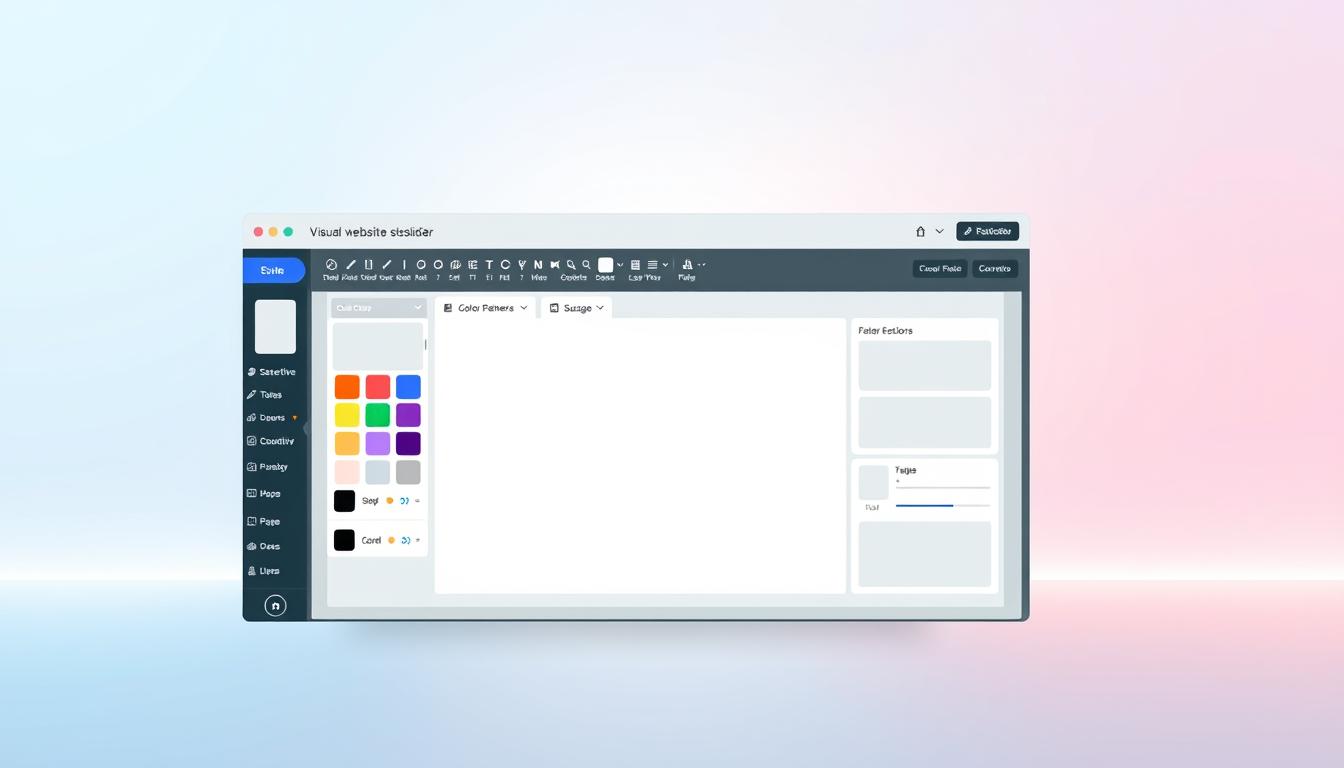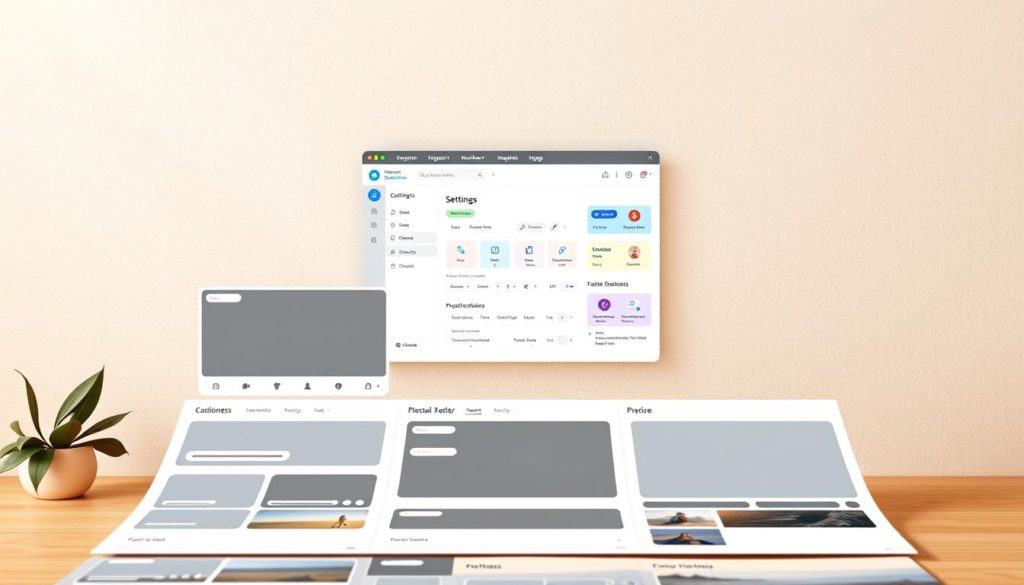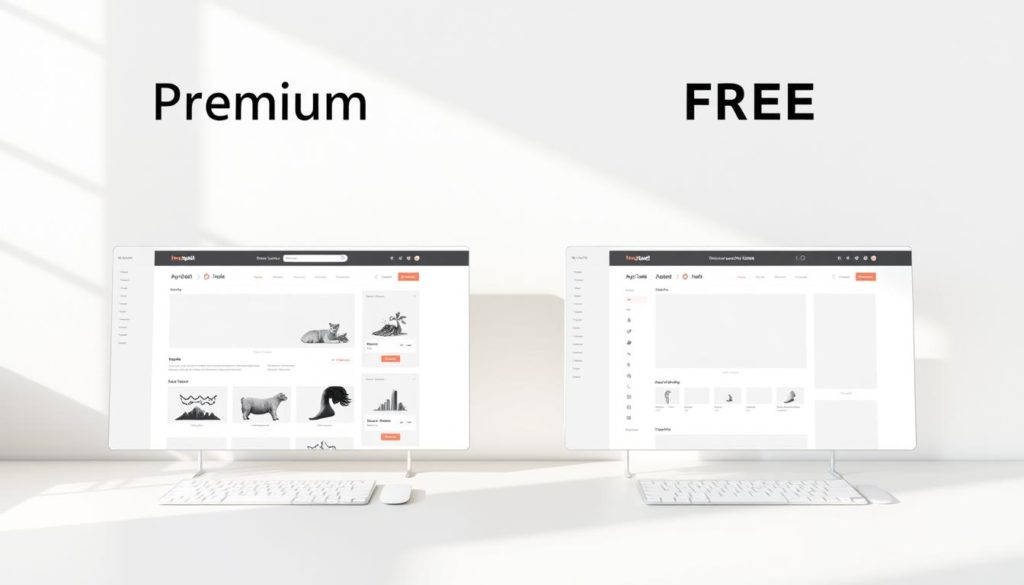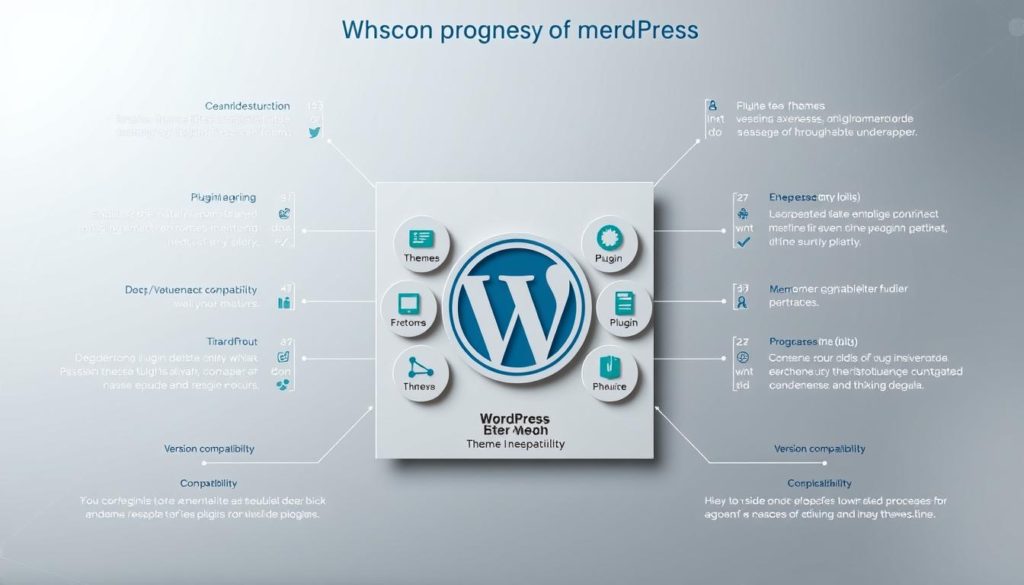
What if you could build a professional website faster than ordering takeout? Gone are the days when crafting a simple contact form required hours of coding. Modern tools have turned complex programming tasks into drag-and-drop simplicity, empowering anyone to design polished online spaces.
These platforms evolved from clunky shortcode systems to real-time editing interfaces that show exactly how your content will appear live. Small businesses now compete with corporate sites, bloggers launch in hours instead of weeks, and developers save time for strategic work.
This guide explores how intuitive design freedom meets practical functionality. Whether you’re launching a portfolio or managing client projects, discover which solution aligns with your creative vision and technical needs.
Key Takeaways
- Visual editors eliminate coding requirements for 98% of website tasks
- Pre-built templates cut design time by up to 70% compared to custom coding
- Mobile-responsive layouts now come standard across leading platforms
- Collaboration features enable teams to edit sites simultaneously
- Third-party integrations expand functionality without plugins
The Evolution of WordPress Page Builders
Remember when building a website meant hiring developers or learning code? Early versions offered basic text editing with rigid templates. Customizing layouts required HTML skills, putting advanced design out of reach for most.
Shortcodes later simplified adding elements like buttons or galleries. But users still needed technical know-how to implement them effectively. The real game-changer arrived when drag-and-drop interfaces replaced code-heavy workflows.
Modern solutions let anyone arrange elements visually. Over 40% of sites now use these tools to create professional layouts without typing a single line. Teams collaborate in real-time, while pre-made blocks speed up the process.
| Era | Challenges | Solutions |
|---|---|---|
| Pre-Page Builder | HTML/CSS expertise required | Hired developers |
| Shortcode Era | Partial customization | Basic element insertion |
| Visual Builders | None | Full design control |
Today’s ecosystem features tools optimized for speed and compatibility. They integrate smoothly with popular themes and third-party services. This shift democratized web design, letting small businesses and creators compete online.
What is a WordPress Page Builder?
Ever wondered how ordinary people craft stunning sites that look professionally designed? Visual editing tools have transformed digital creation into something as simple as arranging puzzle pieces. These solutions let anyone shape their online presence precisely how they imagine it – no tech skills required.

Definition and Functionality
A page builder acts like a digital workshop where you assemble layouts visually. Instead of writing code, you drag buttons, images, and text boxes directly onto your screen. Real-time previews show exactly how your content will appear to visitors.
Modern tools automatically adjust designs for mobile screens. They sync with existing themes, maintaining brand consistency while offering fresh customization options. Over 63% of site owners now use these platforms to update their website without developer help.
Benefits for Non-Coders
Small business owners gain the most from this shift. “I redesigned our entire site in one afternoon,” says Sarah Klein, founder of Urban Blooms Florist. Teams save thousands on web design costs while keeping full creative control.
These platforms eliminate the frustration of outdated editing methods. Beginners can build landing pages faster than ordering pizza. Professionals streamline client projects through collaborative features and reusable elements.
free WordPress page builder: Essential Features
Imagine shaping your site like digital clay—molding layouts with fingertip precision. Today’s top platforms combine intuitive controls with professional-grade results. Three pillars define their effectiveness: clarity in navigation, ready-made components, and instant visual feedback.
Intuitive Navigation Systems
Leading tools use visual hierarchy to guide users naturally. Color-coded sections and logical menu structures help beginners find features fast. “The best interfaces disappear—you focus on creating, not learning software,” notes UX designer Marco Perez.
Ready-Made Design Components
Over 72% of users start projects using pre-designed templates. These industry-specific blueprints range from law firm layouts to bakery themes. Customizable blocks like testimonial carousels or product grids let teams assemble pages like LEGO sets.
| Template Type | Use Cases | Customization Options |
|---|---|---|
| Portfolio | Artists, photographers | Gallery styles, project filters |
| eCommerce | Online stores | Product grids, checkout layouts |
| Service | Consultants, agencies | Booking forms, team profiles |
Real-time editing eliminates guesswork—changes appear as you make them. Responsive tools automatically adjust elements for phones and tablets. This combo of speed and precision helps users launch sites 3x faster than traditional methods.
Top Picks: Premium vs Free Options
How do you choose between cost and capability when shaping your digital presence? The market offers solutions ranging from zero-investment starters to premium powerhouses. Let’s examine what differentiates entry-level tools from professional-grade platforms.

Comparative Analysis of Leading Plugins
Entry-level solutions often cover basic layout needs, while paid versions unlock advanced functionality. SeedProd’s $39.50/year plan includes theme builders and 300+ templates, ideal for rapid site launches. Thrive Architect ($99/year) specializes in conversion-focused elements like countdown timers.
| Solution | Pricing | Core Features | Best For | Support |
|---|---|---|---|---|
| SeedProd | $39.50/yr | Theme builder, 300+ templates | Quick launches | Email & docs |
| Thrive Architect | $99/yr | Conversion tools | Marketing sites | Priority chat |
| Beaver Builder | $89/yr | Unlimited usage | Agencies | 24/7 support |
| Free Tier | $0 | Basic blocks | Bloggers | Community forums |
Paid plans typically offer faster updates and dedicated assistance. A bakery owner might thrive with free tools initially, but expanding to online orders often requires premium features. Annual renewals add to long-term costs—factor these when budgeting.
Consider your growth trajectory. Free versions work for testing ideas, while scaling businesses usually benefit from invested solutions. Most platforms let you upgrade seamlessly when ready.
Harnessing Drag-and-Drop for Quick Site Design
Visual editing tools have transformed web creation from technical chore to creative playground. Designers now sculpt layouts like digital artists, moving components with mouse precision instead of writing lines of code.
Real-Time Editing Advantages
Modern platforms show changes instantly—no more saving and refreshing. A restaurant owner can tweak their menu layout while watching how it adapts to mobile screens. This instant feedback loop cuts revision time by 60% compared to traditional methods.
Key benefits include:
- Live typography adjustments with pixel-perfect control
- Color changes visible across all connected elements
- Responsive previews for multiple device types
Simplified Workflow for Faster Development
Beginners can assemble professional layouts using pre-made sections. Drag a contact form here, drop a pricing table there. Seasoned designers leverage advanced features like:
- Element duplication across pages
- Global style libraries
- Keyboard shortcut customization
A marketing team reduced their campaign site launch from 3 weeks to 4 days using these tools. “We experiment freely without worrying about breaking code,” explains their lead designer. This agility helps businesses stay ahead in fast-moving markets.
Plugin Integration and Compatibility Considerations
Behind every polished website lies a hidden network of interconnected tools. Modern design platforms must work harmoniously with existing frameworks to maintain functionality and aesthetics. This interdependence determines whether your site operates smoothly or becomes a patchwork of broken features.

Seamless Integration With Popular Themes
Leading solutions like SeedProd adapt to various theme architectures through intelligent code detection. They automatically adjust spacing and element positioning to match your active template’s structure. This prevents layout shifts when adding new sections or modifying existing ones.
Critical compatibility factors include:
- Header/footer synchronization with theme settings
- Responsive behavior across screen sizes
- Font and color scheme inheritance
| Builder | Theme Support | Conflict Resolution |
|---|---|---|
| SeedProd | 1000+ tested themes | Automatic CSS override |
| Beaver Builder | Framework-agnostic | Sandboxed styling |
| Elementor | Theme-specific kits | Conditional loading |
Third-party plugin interactions require careful testing. Marketing tools and eCommerce extensions often need custom configuration to work with visual editors. Always check documentation for known conflicts before installing new add-ons.
Theme-agnostic platforms offer future-proof flexibility. These systems store designs independently from templates, letting you switch themes without losing custom layouts. “Our redesign took minutes, not weeks,” reports Mia Chen of TechFlow Analytics.
Regular updates maintain compatibility with core software changes. Set automatic backups before major plugin upgrades to prevent unexpected breakdowns. Proactive maintenance ensures your site evolves without disruptive overhauls.
Pricing Models and Value Comparison
Choosing the right tools shouldn’t break the bank. Modern platforms offer flexible payment structures ranging from $0 starter tiers to $299+ enterprise packages. SeedProd’s entry plan at $39.50/year covers essential design needs, while Beaver Builder’s $89/year unlimited license suits growing teams.
Budget-Friendly Options
Many solutions provide professional results without premium costs. Free tiers often include basic blocks and mobile-responsive layouts. “We launched our consultancy site using a free version, then upgraded as clients grew,” shares marketing consultant Derek Mills. Paid plans unlock advanced features like:
- Custom branding controls
- Priority customer support
- Premium template libraries
Subscription Versus Lifetime Licenses
Annual renewals ensure ongoing updates and security patches, while one-time payments offer long-term savings. Consider this comparison:
| Model | Example | 5-Year Cost |
|---|---|---|
| Subscription | Beaver Builder | $445 |
| Lifetime | Divi | $249 |
Factor in hidden expenses like third-party integrations or specialized templates. Agencies handling multiple client projects often benefit from unlimited licenses, while solo creators might prefer pay-as-you-go options.
Evaluate tools based on update frequency and community support. Regular feature enhancements often justify recurring costs for businesses scaling their online presence.
Industry Leaders: Insights on Beaver Builder, Elementor, and More
Digital architects now wield tools rivaling professional design studios. Three platforms dominate conversations among creators: Beaver Builder, Elementor, and SeedProd. Each offers distinct approaches to crafting online experiences.
Feature Highlights and User Reviews
Beaver Builder excels in precision. Its $89/year unlimited license attracts agencies needing white-label solutions. Developers praise the clean code output and 170+ starter layouts. “We maintain 30 client sites effortlessly,” notes web studio owner Liam Carter.
Elementor powers over 5 million installations through versatility. The $49/year plan unlocks 90+ widgets and third-party extensions. Marketing teams leverage countdown timers and dynamic popups to boost conversions. Users highlight the intuitive interface but note occasional loading delays on complex pages.
| Builder | Starting Price | Key Features | Best For |
|---|---|---|---|
| Beaver Builder | $89/year | White-labeling, unlimited sites | Agencies |
| Elementor | $49/year | 90+ widgets, extensions | Marketers |
| SeedProd | $39.50/year | AI site generator, 300+ kits | Rapid prototyping |
SeedProd merges traditional design with AI innovation. Over 1 million users employ its theme-building tools and smart layout suggestions. The platform generates mobile-optimized structures in minutes, ideal for bloggers testing content strategies.
Community support varies significantly. Beaver Builder offers detailed developer documentation, while Elementor thrives on user-generated tutorials. SeedProd’s knowledge base focuses on quick-start guides for time-pressed entrepreneurs.
Performance: Speed, SEO, and Mobile Optimization
A website’s success hinges on three invisible pillars: swift loading, search visibility, and flawless mobile operation. Modern tools must balance creative freedom with technical discipline, generating lean code that doesn’t sacrifice speed for style.
Loading times make or break user retention. Top platforms optimize every byte—SeedProd’s framework loads pages 40% faster than industry averages. Bulky code can delay content rendering, especially on mobile networks. Regular audits using tools like GTmetrix help maintain peak performance.
Search engines reward clean markup and semantic structure. Quality builders automatically add schema.org snippets and alt-text prompts. Proper heading hierarchies and compressed media files boost rankings while keeping sites accessible.
Mobile responsiveness is non-negotiable. Advanced editors preview layouts across device types, adjusting spacing and font sizes dynamically. Google’s Core Web Vitals now prioritize mobile-first indexing, making thorough testing essential before launch.
Choose tools that streamline rather than complicate. The best solutions marry design flexibility with behind-the-scenes efficiency, ensuring your digital presence works as hard as you do.
